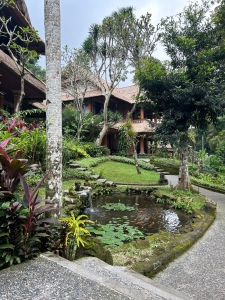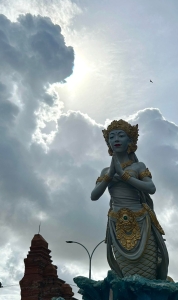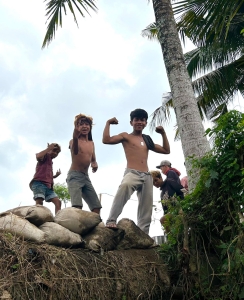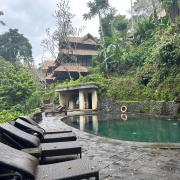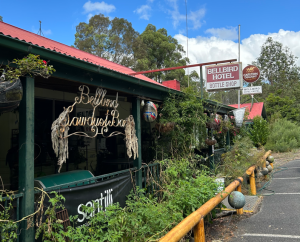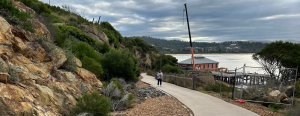Zombie monks, rocky waterfalls, distressed elephants, phallic landmarks and dodgy caiparinha cocktails … welcome to the Thai jungle paradise of Koh Samui.
Coconut island. Or so it used to be. Now the coconuts are imported-on jets from Australia, the UK, Italy, Germany, Japan, mainly.
They’re looking for sun, snorkelling and Singhas. One thing to know, just quickly, is when you get on the turps in Samui, check you’re not drinking real turps, or ethanol as might be the case.
The young fraulein next door at my Fisherman’s Village resort wasn’t so judicious, and copped two bouts of home-brew poisoning from cocktails. Should have learned the first time.
The caiparinhas still taste okay to my mind. A bit odd maybe but the cachaca they’re usually made from can be pretty dodgy anyway. And as my octogenarian Brazilian gynaecologist mate Dr Mario often told me: “Caiparinha can cure a lot of ills but it can create a lot of ills, too.”
Why they’re even selling Rio caiparinhas in Samui’s a fair question but, hey, it’s the tropics. Why not? It’s hardly the only oddity.
My Samui oddities actually start on the plane. The MA128 redeye. Poor Indian bloke lost his shoe, which he’d kicked off before falling asleep. Found it up the other end of the plane after a rigorous search aided by a strident Probus toastmistress telling anyone not blessed with deafness that this poor chap had lost his shoe.
“How could that possibly happen?” she repeats over and over as if an answer would materialise if she asked often enough. But a dozen times doesn’t do it.
My missus, laughing into her airplane pillow almost enough to accident (my new verb), confesses in whispered hysterics: “I kicked it on the floor when I went to the toilet in the middle of the night. I thought I’d keep kicking it and see what happened.”
Ha, ha, yes very droll, I think as I congratulate the poor sable sap on his shoe’s eventual return. He seems buoyed by the feigned concern masking the fear my significant other might burst out laughing. Or worse.
The peculiarities continue apace. At the ethanol bar, Coco Tam’s, I see two young blokes belting the suitcase out of each other shortly before midday. I think it’s part of a promo stunt as a truck-load of midgets drive past bellowing “Tonight, tonight!” to advertise a Muay Thai boxing tournament. It’s something else. They don’t want to discuss it with me.
Strikes me as odd, too, to later see a bullfight on local tellie with excited locals spilling over the fence as two bloodied buffalo rammed heads and horns in a nasty test of testosterone. Drags on for half an hour, again with a screeching harridan beseeching her wager to take out the other beast.
In the end, one bull just ambles off. He’s had enough. So have I. My taxi driver proudly points out the stadium, a dirty paddock, the next day. Certainly no Spanish matador’s gilded arena but I’m warming to the Samui strangeness.
At Wat Kunaram, in the island’s south near Ban Thurian, I find Buddhist devotees praying to Luang Phaw Daeng, a monk who’d predicted the day of his death at age 79 back in the 1970s. He fasted and fed himself a special diet that’s purportedly responsible for his body’s mummified state ever since.
The monk’s corpse sits upright in a large glass case, his head assuming a rock star aspect because of the sunglasses shielding his no doubt spooky-looking eyes from scrutiny.
Yeah, it’s zombie-creepy but the religious ectoplasm floating about lends the show a nice Zen aspect. Monks chanting in the temple to the rear, and another bright and colourful new temple next door again extend further gravity to what’s patently a con.
Not so sure about the jovial monk at the Big Buddha temple at Bo Phut. For a few bob, he happily half-drenched me, splashing water over my head and repeating “Goolark, goolark!” at great pace for a couple of minutes. Tell him I’m on my honeymoon and he nearly falls off his perch laughing.
The “goolark” seems to come to fruition the next morning with a phone call from home with a tidy new contract. The financial reporting season also turns up a larger-than-expected return on a few stocks I’d squirrelled away.
I keep smiling and drive south to Lamai’s Hin Ta and Hin Yai — two rocky protruberances loosely resembling a penis and a female pudenda. Grandpa Rock and Grandma Rock are an immensely popular tourist drawcard with stalls, spielers, restaurants and hotels all around.
Sex might sell in the fleshpots of nearby Chaweng but here it sells in the diluted version of geological anatomy.
A fat Japanese bloke poses on the ground, prostate, with grandpa strategically positioned to emerge from his midriff. Giggling European girls pose with fingers pinching poor old pop in the background. The Muslim girls are up for a laugh, too.
Others place their young children in front of grandpa for a family happy snap. Camera tricks and dick tricks corroborate in a tropical puppetry of the penis.
The Samuis like their rocks. My hotel, the Beluga, is built around them. In addition to its fluorescent indigo, lime, blue and red lighting, the hotel features smart, glazed rocky faces metres high and metres long in the walls of its rooms. My bathroom is a rocky cavern with a shower and a dunny and a few tiles. Quite remarkable, too, if not especially sexy.
It’s Greek-inspired Thai contemporary architecture. All blazing white stone, sparse vegetation – a central frangipani and a palm or two only – and designed by a Frenchman named Roman. Go figure.
Nearby is local tourist trap Valentine’s Rock, which you can pose beneath for 100 baht, alongside hosts of heart-shaped sculptures. Get your toes nibbled by fish in a pond, too, if you fancy. Or pose by the two-metre wooden penis central to the park there. Someone got through Samui Tourism 101 with flying colours.
If you like your rocks hot, you can climb up the hill to a café with a balcony lookout over Lamai and its ever-encroaching palms and jungle, and fishing boats out to sea. A fistful of wooden hashtag signs await your photo-selfie opportunity: #lovely #viewpoint, #hi and the likes.
The German honeymooners who ask me to snap a photo of them have a #inlove sign. Where’s a #frankfurt sign when you need one, I wonder.
A wobbly funicular with cheerful giggling guides, and consignments of coconuts for the café, will take you up upwards if you’re thinking rugged be buggered. Whatever you do, don’t take the car. The grade is ridiculously steep.
Night falls and my neighbours have erected a pair of wooden teepee frames, adorned with fairy lights, and a swag of turquoise bean bags, atop the granite tor adjoining our two hotels. So we sit on the beacon rocks as the sun tumbles behind us into the jungle and fishing boat lights emerge on the horizon. Frosty Singhas complete the scene.
Full-body tattoos, G-strings and bare-butt wide-crochet skirts, hotel staff in white cotton trousers, tees and waist sashes seem the order of the day in this part of the world. If you’re wearing anything, that is. One thing I spy are scars which it unfolds are painful stinger tattoos left on those silly enough to swim in the ocean waters at night. Vinegar and raw alcohol help but best you don’t harbour any such ambitions.
The barman making me a caiparinha, Wun Chai, is a father in waiting. Any day now. His wife and first child are in Myanmar, where he was born. He’s hoping to see them in four or five months, when next he gets shore leave. Long and anxious wait. He shows me pretty photos.
I discover a strange bar among the giant seaside boulders beside Grandpa and Grandma. It’s a reggae bar cum tree house cum memorial to Bob Marley, Jimi Hendrix and Jim Morrison. Not a straight line in the place and two beers under your belt you become a serious leg injury liability. Drop a match and you’d all be toast.
But the place is rather brilliant. Cushions galore, ladder steps everywhere, crooked branch handrails, red and yellow lighting… it’s a kind of deranged Peter Pan Lost Boys cubby hut meets Pirates of the Caribbean Isla de Muerta bar.
It’s called The Rock Bar, of course. Looks like an underground bar buried under dried palm fronds until you delve inside, whereupon it takes on a high-rise aspect from its tangled base between several shoreline boulders.
The scent of cannabis glides up, over and through the bar’s multifarious levels. A Thai-Jamaican band has set up just inches above the incoming sea. I natter to a pleasant young English couple freshly out of India, and its food poisoning/starvation/disease horrors, and now optimistically eyeing Angkor Wat and old Saigon.
I tell them to play it safe in Australia, that our shark-snake-scorpion-spider terrors are greatly overrated. Maybe one day, they suggest. They’d rather take their chances just about anywhere else.
I wonder on, gently buzzed with caiparinha and Chang. I trip over a glass artisan busy fire-blasting a blue-eared sausage dog. Then a coach-load of Japanese tourists descending on a massive timbered seafood eatery. Then a snapper in tamarind sauce at a humble adjoining beachside restaurant where alluring chargrill scents mix uneasily with sewerage pongs. The tamarind wins, just.
The cats and dogs are plump, their pelts thick and clean, and their demeanour strangely amicable. The cat doesn’t even chase a mouse I spot on the sand. Just looks and moves on. The mouse shits itself, mind you, and whips out of its path.
One more oddity. The place doesn’t look so prosperous that the mutts shouldn’t be mangy and distemper-afflicted. And I wonder what’s happened to rabies, nature’s way of keeping the animal kingdom from taking us over.
Inland at Na Mueang waterfall, an 80-metre cascade in a pretty jungle hideaway, visitors skid and slide over slippery rocks as they seek out their perfect snapshot. Auto apertures can’t cope with the dark foliage and brilliant sunlight, though, resulting in indistinct silhouette shots.
Long-suffering elephants, swaying sadly in their chained misery, are coerced upriver to the falls with loads of tourists on their backs. The river’s anything but a sandy passage. It’s rocks, rocks and more rocks. One slip by the pachyderm and everyone’s cactus.
The island’s centre, a mess of hills covered by palms after earlier being denuded of the trees, hosts a criss-cross of roads, back-tracks and short-cuts to avoid the coastal towns. Lamai to Mae Nam takes me little more than 20 minutes in a brand-new cab with an enthusiastic driver keen to test the brakes at speed.
Mae Nam, looking out across the turquoise to Koh Pha-Ngan and Koh Toa, is a mess of hotels and resorts, dusty roads, shops and houses. And tourists seeking out Family Marts, 7-Elevens and stores with cheaper meals, snacks and beers than the hotels offer.
Inside the hotels, visitors sunbake, drink, swim and eat between yoga downward dogs, deep-tissue massages and self-pedicures walking the abrasive beachfronts. I splash about for a bit, laze about and scoff a pad thai from a neighbouring beach restaurant before sidling up to a prospective drinking buddy at the pool bar.
We bang on about San Diego and Sarawak golf courses, kangaroos, Thai food, Bangkok, the Frankfurt Motor Show, Italian and Brazilian thieves, Japan and a rambling agenda of loose travel-related stuff. Caiparinhas and Changs. Great conversationalists the two of us, hic!
